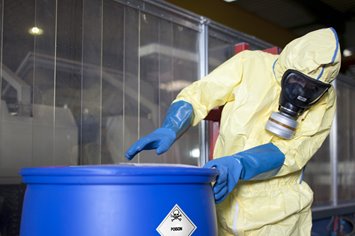Hazmat Video Essentials: The 9 Hazard Classes
Assigning a hazardous material to correct hazard class or division is a crucial early step in the shipping process. In video #2 of the Hazmat Shipping Essentials series, we explore all nine Classes of hazardous materials regulated around the world (and their Divisions).
Hazardous Materials: All 9 Hazard Classes Explained
There are nine (9) types or categories of hazmat, called Hazard Classes, with some Classes separated into sub-categories called Divisions. When you are the one who offers hazmat into transportation, you are the one responsible for your material being properly classified based on its hazards. All shippers must comply with all applicable US DOT hazmat rules, and compliance begins with an accurate classification.
Hazard Class 1 (Explosives)
Hazard Class 1 is the Explosives class, and it’s made up of six divisions that cover a broad range of materials and articles, from flat-out weapons of war that pose a “mass explosion hazard” to consumer fireworks big and small.
Also in Class 1 you’ll find chemical propellants, dynamite, detonators, gunpowder, gun ammunition, grenades, flares, rockets, and more, including things you might not think of as “hazardous” - like some car airbag and seatbelt systems.
If you want to go deeper into the criteria for what makes something explosive, or flammable, or poisonous, Lion’s free Hazmat Shipper Starter Guide begins with hazmat classification.Hazard Class 2 (Gases)
Hazard Class 2 is for materials in a gaseous state. Class 2 is made up of three Divisions. Division 2.1 materials are flammable gases like butane, propane, and methane. 2.2’s are non-flammable, non-poisonous gases—e.g., cryogenic gases and gases that act as asphyxiants or oxidizers.
Division 2.3 gases are poison by inhalation—these include sulfur dioxide, chlorine gas, and carbon monoxide.
Hazard Class 3 (Flammable Liquids)
Hazard Class 3 is the hazard class for Flammable and Combustible Liquids. A Class 3 hazmat is a liquid that is vulnerable to catching fire at temperatures low enough to be a concern in transport.
Class 3 is the by far most-transported hazard class in the US—it’s stacked with heavy-hitter hazardous materials like alcohols, fuel and heating oils, and widely used chemicals like acetone, benzene, and turpentine.
Hazard Class 4 (Flammable Solids)
Hazard Class 4 covers flammable and reactive solid materials. Division 4.1 covers flammable and self-reactive solids—that can be everything from magnesium metal to matchbooks to scraps of rubber to dry vegetable or cotton fibers.
Division 4.2 is for spontaneously combustible material. These can be pyrophoric—things that go up in flames within 5 minutes of touching air; or self-heating materials, which react with oxygen and generate heat.
Division 4.3 materials are Dangerous When Wet materials. Dangerous When Wet materials are liable to become flammable or give off toxic gas when they contact water. Sodium and zinc metal are examples.
Hazard Class 5 (Oxidizers and Organic Peroxides)
There are two divisions to Class 5—oxidizers in Division 5.1 and organic peroxides in Division 5.2.
Oxidizers are materials that give off oxygen. What’s hazardous about that? Oxygen is one of three things that a fire needs to ignite and survive. If it’s near a fuel and a source of ignition, a Division 5.1 material can contribute to a fire starting or make any fire stronger.
Ammonium nitrate fertilizer is a Division 5.1 hazardous material, one that was involved in two tragic disasters in recent memory—in West, Texas in 2013 and Beirut, Lebanon in 2020.Organic peroxides are compounds that contain oxygen and have a specific molecular structure. They are unstable by nature and pose a risk of fire and/or explosion when exposed to heat, impact, friction, light, sparks, or other stimuli.
Hazard Class 6 (Poisons and Infectious Substances)
Class number six is split into two divisions: Division 6.1 materials are poisonous materials—except for poison gases, which remember are with the other gases in Hazard Class 2. Division 6.1 materials are presumed toxic to humans based on test results for oral, skin, or inhalation exposure.
Materials that can cause extreme irritation—like tear gas—are also 6.1’s. Division 6.2 materials are infectious substances. These are materials known or reasonably expected to contain a pathogen, such as a virus or bacteria, that makes humans or animals sick.

Hazard Class 7 (Radioactives)
Class 7 is for radioactive materials. These include waste from nuclear power plants as well as materials that contain radionuclides and are used in medical equipment, medical gages, and even medicines.Hazard Class 8 (Corrosives)
Corrosive materials are assigned to Hazard Class 8.
Liquid or solid materials get put in Class 8 because they can severely damage and destroy human skin, steel, or aluminum over time. Sulfuric acid, hydrochloric acid, and sodium hydroxide are all Class 8 hazardous materials.
Hazard Class 9 (Miscellaneous)
Last but not least, Hazard Class 9 is the home for misfit or miscellaneous hazardous materials. Class 9 is for the stuff that doesn’t fit into ANY of the eight classes we already talked about BUT is nonetheless regulated as hazmat. There’s a lot more to say about Class 9: Subscribe to Lion's YouTube channel to follow the series and catch our next video all about Hazard Class 9!

2026 Training Schedule Available Now:
Hazmat and RCRA Workshops & Webinars
Lion's 2025 schedules of workshops and webinars for hazardous waste professionals and shippers of hazmat/DG are available now! Find out when Lion's hazmat/DG and RCRA training will be in your area next—or find a webinar that fits your schedule.
Lion.com/Workshop
Lion.com/Webinar
Tags: hazardous materials, Hazmat Shipping Essentials, video
Find a Post
Recent Posts
Compliance Archives
Download Our Latest Whitepaper
Shipping papers are a crucial part of safely shipping hazardous materials. See the top 5 mistakes shippers make on shipping papers, and how to avoid them.

By submitting your phone number, you agree to receive recurring marketing and training text messages. Consent to receive text messages is not required for any purchases. Text STOP at any time to cancel. Message and data rates may apply. View our Terms & Conditions and Privacy Policy.
